The Microserver IC Market is estimated to be valued at USD 1.9 billion in 2025 and is projected to reach USD 6.7 billion by 2035, registering a compound annual growth rate (CAGR) of 13.3% over the forecast period.
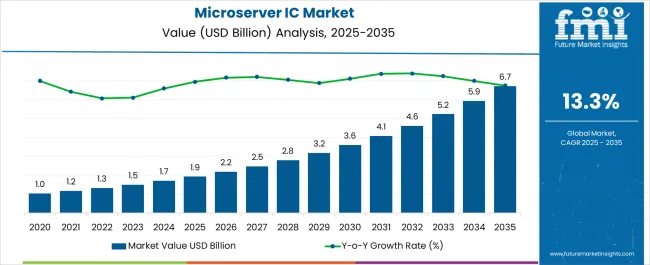
| Metric | Value |
|---|---|
| Microserver IC Market Estimated Value in (2025 E) | USD 1.9 billion |
| Microserver IC Market Forecast Value in (2035 F) | USD 6.7 billion |
| Forecast CAGR (2025 to 2035) | 13.3% |
The Microserver IC market is witnessing notable expansion, fueled by rising demand for energy-efficient and high-density computing solutions across data-intensive industries. These processors are designed to handle lightweight and parallel workloads, making them highly suitable for applications such as web hosting, media storage, and cloud-based services. The growing need for scalable infrastructure in small to medium-sized enterprises, coupled with the rising adoption of edge computing, is significantly supporting market growth.
Hardware efficiency, reduced power consumption, and the ability to optimize performance for specific tasks have positioned microserver ICs as a preferred choice for next-generation data centers. Increasing reliance on digital services, streaming platforms, and content delivery networks continues to generate large volumes of data, creating demand for efficient storage and computing platforms.
Moreover, rapid advancements in processor architectures and integration of AI capabilities are shaping the technological landscape With continued investment in hyperscale data centers and decentralized computing networks, the Microserver IC market is expected to maintain robust growth momentum, driven by cost optimization and improved performance efficiency.
The microserver ic market is segmented by component, processor type, application area, and geographic regions. By component, microserver ic market is divided into Hardware, Software, and Services. In terms of processor type, microserver ic market is classified into Intel, ARM, and AMD. Based on application area, microserver ic market is segmented into Media Storage, Internet Data Centers, Analytics, Cloud Computing, and Others. Regionally, the microserver ic industry is classified into North America, Latin America, Western Europe, Eastern Europe, Balkan & Baltic Countries, Russia & Belarus, Central Asia, East Asia, South Asia & Pacific, and the Middle East & Africa.
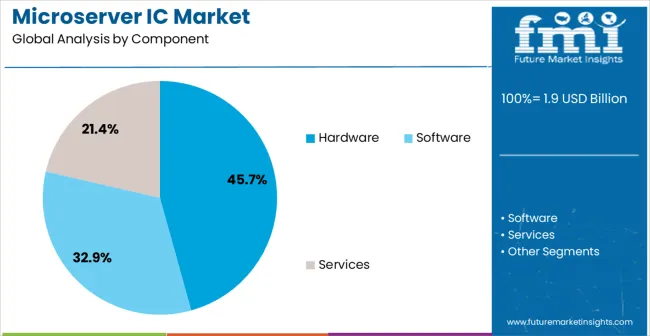
The hardware component segment is projected to account for 45.7% of the Microserver IC market revenue in 2025, positioning it as the leading component type. This growth is being driven by the increasing demand for compact and efficient hardware systems that can support microservers in data-intensive environments. Hardware solutions, including processors, memory units, and storage controllers, are essential in enabling seamless workload distribution and high computing efficiency.
The emphasis on reducing energy consumption while maintaining performance scalability is encouraging enterprises to adopt hardware-driven solutions tailored to microserver needs. Technological advancements such as system-on-chip (SoC) designs and modular architectures are further enhancing efficiency and lowering deployment costs.
Hardware remains indispensable in ensuring reliability, durability, and high performance under demanding workloads, particularly in cloud computing, content delivery, and enterprise data centers As organizations prioritize resource optimization and high-density server deployment, the hardware component segment is expected to maintain its leadership role, supported by continual innovations and strong market demand for robust infrastructure solutions.
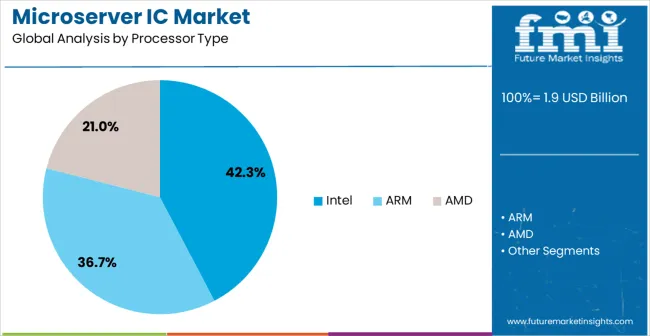
The Intel processor type segment is anticipated to hold 42.3% of the Microserver IC market share in 2025, making it the leading processor type. This dominance is being supported by Intel’s long-standing expertise in semiconductor design and its widespread adoption across global enterprises. Intel processors are recognized for their performance efficiency, compatibility, and extensive ecosystem support, which makes them highly suitable for microserver applications.
The company’s strong focus on developing low-power, high-density processors tailored for data centers and edge computing environments is further reinforcing market leadership. Intel’s investment in next-generation architectures and integration of AI acceleration capabilities enhances microserver performance, particularly in handling data-heavy and parallel workloads.
Broad availability, scalability, and well-established trust among enterprises are strengthening Intel’s position as the primary processor choice As demand increases for energy-efficient computing platforms that can optimize resource utilization while maintaining flexibility, Intel processors are expected to remain central to market growth, driven by technological innovation and industry-wide adoption.
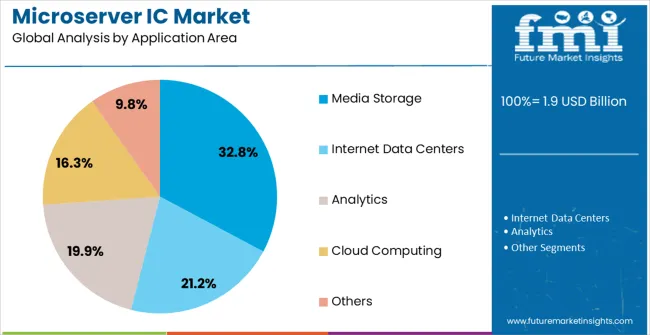
The media storage application area segment is expected to account for 32.8% of the Microserver IC market revenue in 2025, making it the leading application segment. Growth in this area is being driven by the explosive demand for streaming platforms, digital content services, and data-heavy applications that require scalable storage infrastructure. Microserver ICs offer advantages in energy efficiency, space optimization, and workload management, which are critical in supporting media storage operations.
These processors enable high-density data storage solutions while minimizing operating costs and power consumption, which is crucial for enterprises managing large content libraries. The growing adoption of cloud-based storage, video-on-demand platforms, and digital archiving solutions further reinforces this segment’s growth trajectory.
Additionally, media companies are leveraging microserver ICs to ensure reliable, fast, and cost-effective storage infrastructure that can scale with rising consumer demand As content delivery networks and digital streaming platforms continue to expand globally, the media storage application area is projected to retain its leading position, supported by technological advancements and increasing reliance on efficient computing systems.
A microserver is a small server appliance which is based on a system on a chip (SoC). Most of the server motherboard functions are integrated on a single microchip, except DRAM, boot FLASH and power circuits. Thus, the main chip contains more than only compute cores, caches, memory interfaces and PCI controllers.
Microservers offers benefits such as low power and space consumption, distributed resources and scale out workloads that use large numbers of lightweight server nodes. Major application areas of microservers include media storage and Internet data center, especially for applications such as lightweight web serving, simple content delivery nodes, and low-end dedicated hosting.
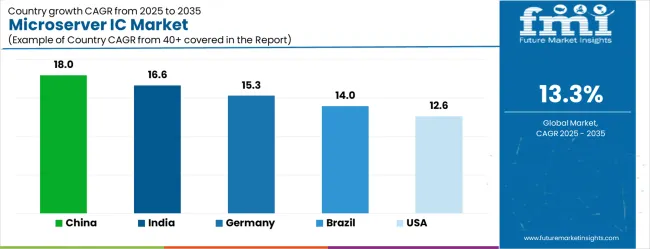
| Country | CAGR |
|---|---|
| China | 18.0% |
| India | 16.6% |
| Germany | 15.3% |
| Brazil | 14.0% |
| USA | 12.6% |
| UK | 11.3% |
| Japan | 10.0% |
The Microserver IC Market is expected to register a CAGR of 13.3% during the forecast period, exhibiting varied country level momentum. China leads with the highest CAGR of 18.0%, followed by India at 16.6%. Developed markets such as Germany, France, and the UK continue to expand steadily, while the USA is likely to grow at consistent rates. Japan posts the lowest CAGR at 10.0%, yet still underscores a broadly positive trajectory for the global Microserver IC Market. In 2024, Germany held a dominant revenue in the Western Europe market and is expected to grow with a CAGR of 15.3%. The USA Microserver IC Market is estimated to be valued at USD 664.7 million in 2025 and is anticipated to reach a valuation of USD 664.7 million by 2035. Sales are projected to rise at a CAGR of 0.0% over the forecast period between 2025 and 2035. While Japan and South Korea markets are estimated to be valued at USD 89.7 million and USD 56.4 million respectively in 2025.
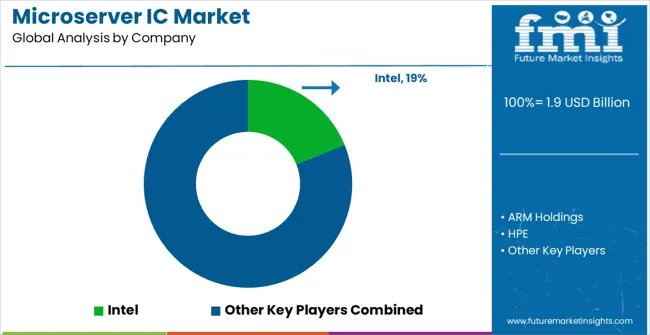
| Item | Value |
|---|---|
| Quantitative Units | USD 1.9 Billion |
| Component | Hardware, Software, and Services |
| Processor Type | Intel, ARM, and AMD |
| Application Area | Media Storage, Internet Data Centers, Analytics, Cloud Computing, and Others |
| Regions Covered | North America, Europe, Asia-Pacific, Latin America, Middle East & Africa |
| Country Covered | United States, Canada, Germany, France, United Kingdom, China, Japan, India, Brazil, South Africa |
| Key Companies Profiled | Intel, ARM Holdings, HPE, Dell, Quanta Computer, Applied Micro Circuits, Marvell Technology, Cavium, Penguin Computing, and Ambedded Technology |
The global microserver IC market is estimated to be valued at USD 1.9 billion in 2025.
The market size for the microserver IC market is projected to reach USD 6.7 billion by 2035.
The microserver IC market is expected to grow at a 13.3% CAGR between 2025 and 2035.
The key product types in microserver IC market are hardware, software and services.
In terms of processor type, intel segment to command 42.3% share in the microserver IC market in 2025.






Our Research Products

The "Full Research Suite" delivers actionable market intel, deep dives on markets or technologies, so clients act faster, cut risk, and unlock growth.

The Leaderboard benchmarks and ranks top vendors, classifying them as Established Leaders, Leading Challengers, or Disruptors & Challengers.

Locates where complements amplify value and substitutes erode it, forecasting net impact by horizon

We deliver granular, decision-grade intel: market sizing, 5-year forecasts, pricing, adoption, usage, revenue, and operational KPIs—plus competitor tracking, regulation, and value chains—across 60 countries broadly.

Spot the shifts before they hit your P&L. We track inflection points, adoption curves, pricing moves, and ecosystem plays to show where demand is heading, why it is changing, and what to do next across high-growth markets and disruptive tech

Real-time reads of user behavior. We track shifting priorities, perceptions of today’s and next-gen services, and provider experience, then pace how fast tech moves from trial to adoption, blending buyer, consumer, and channel inputs with social signals (#WhySwitch, #UX).

Partner with our analyst team to build a custom report designed around your business priorities. From analysing market trends to assessing competitors or crafting bespoke datasets, we tailor insights to your needs.
Supplier Intelligence
Discovery & Profiling
Capacity & Footprint
Performance & Risk
Compliance & Governance
Commercial Readiness
Who Supplies Whom
Scorecards & Shortlists
Playbooks & Docs
Category Intelligence
Definition & Scope
Demand & Use Cases
Cost Drivers
Market Structure
Supply Chain Map
Trade & Policy
Operating Norms
Deliverables
Buyer Intelligence
Account Basics
Spend & Scope
Procurement Model
Vendor Requirements
Terms & Policies
Entry Strategy
Pain Points & Triggers
Outputs
Pricing Analysis
Benchmarks
Trends
Should-Cost
Indexation
Landed Cost
Commercial Terms
Deliverables
Brand Analysis
Positioning & Value Prop
Share & Presence
Customer Evidence
Go-to-Market
Digital & Reputation
Compliance & Trust
KPIs & Gaps
Outputs
Full Research Suite comprises of:
Market outlook & trends analysis
Interviews & case studies
Strategic recommendations
Vendor profiles & capabilities analysis
5-year forecasts
8 regions and 60+ country-level data splits
Market segment data splits
12 months of continuous data updates
DELIVERED AS:
PDF EXCEL ONLINE
Ice Cream Coating Market Size and Share Forecast Outlook 2025 to 2035
Ice-cream Premix and Stabilizers Market Size and Share Forecast Outlook 2025 to 2035
ICE Start And Stop System Market Size and Share Forecast Outlook 2025 to 2035
ICD-10 Market Size and Share Forecast Outlook 2025 to 2035
Ice Cream Equipment Market Size and Share Forecast Outlook 2025 to 2035
Ice Boxes Market Size and Share Forecast Outlook 2025 to 2035
Icing Shortening Market Size, Growth, and Forecast for 2025–2035
Analysis and Growth Projections for Ice Cream and Frozen Dessert Market from 2025 to 2035
Icing Sugar Market Analysis - Size, Share, and Forecast 2025 to 2035
Ice Cream Packaging Market - Outlook 2025 to 2035
Analysis and Growth Projections for Iced Tea Business
Ice Cream Processing Equipment Market Growth - Trends, Demand & Innovations 2025 to 2035
Ice Cream Service Supplies Market - Premium Serving Essentials 2025 to 2035
Ice Detection System Market Trends, Growth & Forecast 2025 to 2035
Ice Cream Parlor Market Analysis by Type, Product Type, and Region Through 2035
Breaking Down Market Share in the Ice Cream Parlor Industry
Ice Cube Tray Market Trends & Growth Forecast 2024-2034
Ice Cream Container Market Size & Trends Forecast 2024-2034
ICU-acquired Acute Kidney Treatment Market
Ice Maker Machines Market

Thank you!
You will receive an email from our Business Development Manager. Please be sure to check your SPAM/JUNK folder too.
Chat With
MaRIA